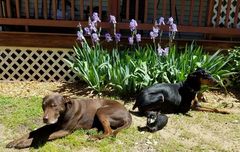
For about the fist six months of a puppies life, training goes along usually with minimal corrections (like no, trading items, or redirection to something more appropriate) and punishment might be a simple crate time out. Hopefully you have been doing formal training during this point, which does have less expectation and precision than one would have of a more mature dog going through training.
There are rules that humans need to adhere to for corrections to be an effective and fair part of a training plan. Here are five rules that most often come to mind for me:
- Training and teaching always are the first things you do with your dog before correcting them for non compliance. They need to know what the right decision, position or behavior was before you can expect them to perform it. A correction is not the beginning teaching step. Also remember a correction is not the reaction to an unpleasant event (IE dog bite, growling, going to the bathroom in the house, getting into the garbage ET). We are not talking about that here, and those reactions are not part of the TRAINING process in specific.
- Related to above, a correction must be fair and appropriate to the situation. Remember even when using training collars, the handler/trainer/owner always has control over how much they are used, how well timed they are used, and how consistent they have been in general to the training plan.
- A correction happens when the human is calm and in a good frame of mind. Again a correction is not something that happens in anger or frustration.
- There is usually a second or so between an event (command, behavior, ET) where the dog is giving their learning space. Then a correction (body bump, re-position, molding, collar/leash correction) is given only after giving the dog the opportunity to act based on what you have already taught them. Without giving them that space, you are not giving them the space to think, contemplate, and decide what it is that you want.
- Corrections are never the only information given in a training plan. They are a tool just like anything else that you use for training (leash, collar, voice, body language, consistency, timing, and so on). If you only used correction, you would never be teaching or rewarding. These are ALL part of the training process.
If you need help training your dog, please call, e-mail ([email protected]), or fill out our client interview form.
 RSS Feed
RSS Feed